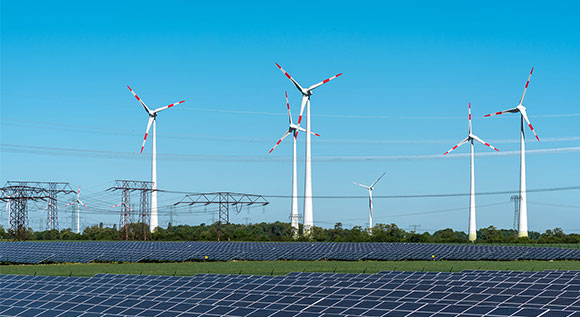Monitoring report: increased use of renewables, but a lot remains to be done
Today, one in three kilowatt-hours comes from renewable energy. However, as shown by the new monitoring report, a lot remains to be done in order to make a success of the energy transition.
 © iStock.com/elxeneize
© iStock.com/elxeneize
Around one and a half years ago, the Federal Government presented the 2017 version of the Renewable Energy Sources Act, thereby spurring competition in the renewable energy sector. It is now becoming clear that determining funding rates based on competitive auctions is indeed helping to expand renewable energy in a more cost-effective manner. In addition to this, 31.6 per cent of gross electricity demand was met by renewables in 2016.
And the Federal Government’s sixth monitoring report provides for more good news on the energy transition: it shows that Germany’s electricity supply is secure. Energy demand can be covered around the clock, and a secure supply of electricity is guaranteed. This makes Germany one of the global leaders on the energy transition. Germany was also able to put a hold on rising electricity prices: in 2016, prices for residential customers remained generally stable compared with the previous year.
However, in the same year, energy consumption increased by 1.4 per cent – which was mainly due to relatively low temperatures and strong economic growth. Greenhouse gas emissions also saw a slight increase. The Federal Government is currently looking at additional measures that could be taken in addition to its 2020 Climate Action Plan and that would help protect the climate.
The energy transition is a project of historic proportions. In order to make a success of it, grid capacity needs to be better dovetailed with the amounts of electricity that are being generated and fed into the grid. According to the new monitoring report that was presented by the Federal Cabinet last week, this means that the grid needs to be expanded more quickly and that existing grids need to be updated.
The Monitoring Report – an annual update of the facts relating to the energy transition
The Federal Government has launched a monitoring process entitled “Energy of the Future” in order to continuously monitor the development of the energy transition and to provide a fact-based overview of the status of the implementation of the energy transition. This means that the government scrutinizes measures that it has taken in the past and looks at what additional measures might be needed. The Federal Ministry for Economic Affairs and Energy is the lead ministry for this monitoring process, and is also responsible for presenting a monitoring report each year. This is also part of the government’s reporting duties set out the Energy Industry Act and the Renewable Energy Sources Act.
The monitoring report aggregates all of the information available and presents it in an easy-to-understand and transparent manner. This means that the general public will be informed at all times about which measures are being implemented as part of the energy transition, how effective these are and whether the government is able to meet its goals or whether additional measures need to be taken.

